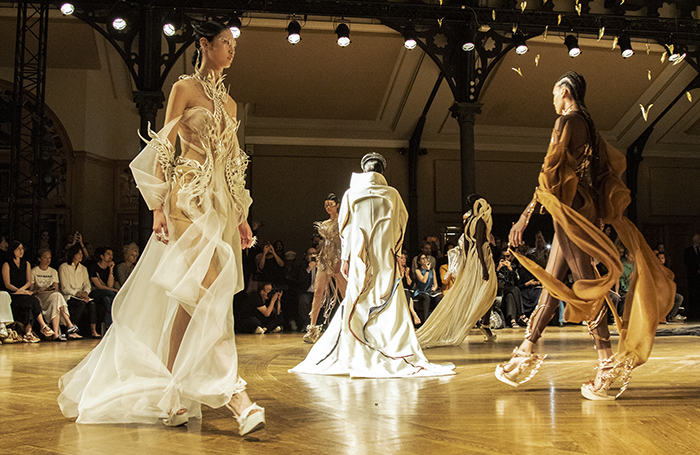The artistic ingenuity of fashion designer Iris van Herpen has hewn a new path for haute couture. Drawing on dance, choreography, science, architecture, music and new technology, her sublime designs are not only otherworldly but exquisitely crafted. This season she explores the metaverse. Story by Jeanne-Marie Cilento. Reporting by Ambrogio de Lauro. Photography by Elli Ioannou
 |
Sparkling crystals hang from the tips of the silken leaves creating a glimmering aura |
Iris van Herpen's new major exhibition will be held in Paris at the Musée des Arts Décoratifs
 |
Casey Curran's sculpture of Daphne on the runway with Apollo as fluttering golden leaves |
The sculpture's gilded skeleton sprouts abstract white blooms like living flora, representing the laurel tree. The work floated at the centre of the space like a talisman. The quivering golden leaves above the figure were designed to suggest Apollo's unrequited passion for her.
Walking around this potent artwork, the models teetered on winged, 3D printed heels wearing sinuously surreal designs made with an entrancing combination of new technology and superlative hand-crafted expertise.
Many of the lacy, corporeal details are 3D printed and then meticulously hand-sewn together, maintaining the artisan tradition of haute couture yet upending staid preconceptions of form and material.
Key to van Herpen's work is sustainability which she has made an integral part of the design and production process of her collections. Since she founded her label, she has developed new techniques and experimented with materials not usually associated with couture.
She wants to not only push the boundaries of what is considered haute couture but leap beyond them. The designer sees haute couture as a laboratory for experimentation, influencing and inspiring ready-to-wear. Every season is an opportunity to express, in material and digital form, new ideas.
The designer sees haute couture as a fashion laboratory for innovation and experimentation
 |
The Singularity jumpsuit with 3D printed adornments made from leftover cocoa bean shells |
The raw cocoa beans shells are processed into granules and then mixed with glucose. This stabilized substance is then spun into a filament, forming an organic biopolymer that can be 3D printed, making the production of the material entirely sustainable.
As a finishing touch, the embellishments are electroplated with copper. The jumpsuit is interwoven with vegetative tendrils that wreath Cindy Bruna's body encased in upcycled organza.
Another innovative material used by Iris van Herpen in this collection is a biodegradable fabric made from a type of banana called Abaca, originating from the Philippines. The fabric is made of 40% raw silk combined with 60% fibre from the banana plant’s stems.
The Abaca and silk are woven into a shiny material that shimmers with the shine of banana leaves. The designer also worked with Solaris, using recycled Mylar as the base for intricate embroidery and laser cuts. The fine, translucent face jewellery that the models wore for the Paris show was created with artists Staskausas and Lance Victor Moore.
The pellucid fabrics of the collection have a gossamer texture and are in a subtle palette of creams and beiges, giving the models an ethereal, otherworldly grace. Contrasting with these incorporeal figures were those dressed in darker hues of blue and amethyst with a dash of copper and silver to enliven the glistening embellishments.
The sinuously surreal designs are made with an entrancing combination of new technology and superlative, hand-crafted expertise
 |
The Omnipresent dress with it's filmy, spider-web like lace bounded by laser-cut black framework |
The tragic tale of Narcissus, who falls in love with his own reflection, was the impetus that spurred the designer to create luminous surfaces that were layered and reflective. The Narcissus coat (see below) worn by Winnie Harlow is also embroidered with faces that seem to move and then disappear.
The myth of Daphne and Apollo engendered the design of the finale look with Daphne's metamorphosis into a laurel tree. Van Herpen interprets the story as a metaphor for our immersion in virtual worlds where we merge with the metaverse.
She asks questions about what this could look like: "How do we envisage our digital counterparts? Who do we dream of becoming in these digital realms?" Well the designer has given us the answer, with this collection, to the most important question: "What will we wear?"


























